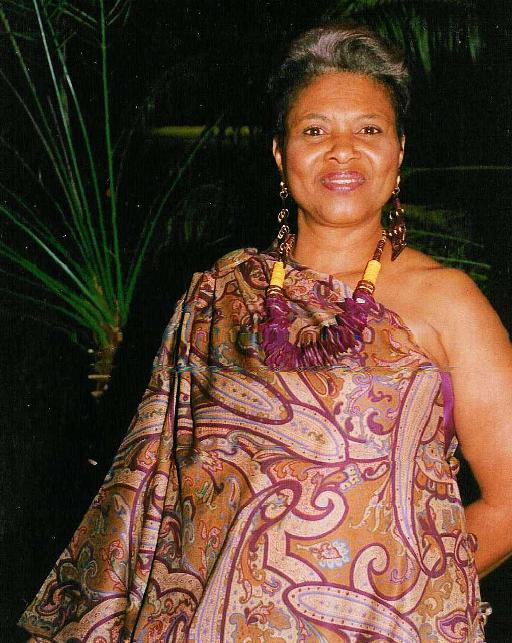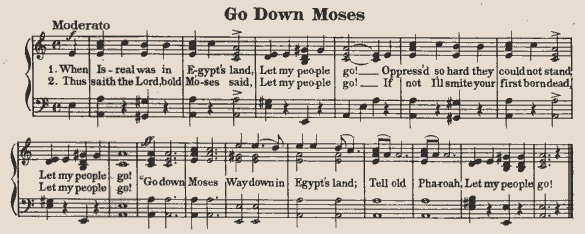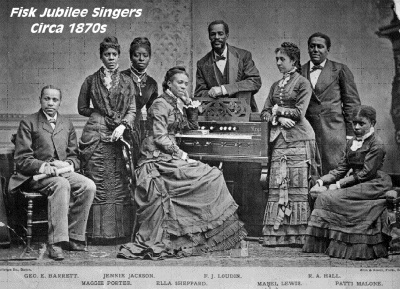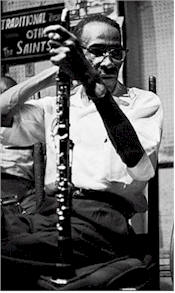
Topsy Chapman. Photo courtesy of the artist.
Turn of the century New Orleans-style jazz had deep roots in Spirituals and Gospel Hymns. Jazz musicians continue to look to church music for inspiration, taking familiar themes and melodies from hymns and swinging them in a jazz band style. The Jim Cullum Jazz Band is no exception. They regularly present their program of hymns and spirituals—such as “Deep River” and "When the Roll Is Called Up Yonder"—in churches of all denominations.
Special guest and Louisiana native Topsy Chapman is very familiar with traditional African-American gospel repertoire. Topsy leads a vocal trio called Solid Harmony with her two daughters, and her father, Norwood Chapman born in 1898, was a vocal music instructor steeped in the gospel tradition. Growing up in her large family, everyone sang hymns in a vocal style particular to his or her own generation. Here, Topsy demonstrates differences between the gospel singing styles of her father's generation and that of her own 1960s contemporaries, like Aretha Franklin.
Explaining the unique place Spirituals hold in the American musical experience, Harry "Sweets" Edison, the great Count Basie trumpeter, had this to say on another Riverwalk Jazz production:
“…Spirituals are one of the oldest forms of art and culture we have in America, jazz and the blues came out of spirituals. Spirituals came out of the days of slavery. My great-grandmother, the one who lived to be 108, she used to tell me about it because she was born in slavery times. You know, they worked from sunup to sundown. Sometimes they worked all night. They worked so hard; they just waited to die, because they would be out of their misery. They sang the Spirituals because the music gave them hope. The music gave them strength to endure the day. They sang for relief.”
On this Riverwalk Jazz production, Topsy Chapman joins The Jim Cullum Jazz Band to perform a variety of Spirituals and Gospel Hymns:

"Go Down Moses." Image courtesy musicofyesterday.com
"Go Down Moses" is a traditional American Negro Spiritual sung by the Fisk Jubilee Singers in the 1870s. The lyric uses an Old Testament narrative from the book of Exodus in which God exhorts Moses to stand up to the Egyptian Pharaoh, who had enslaved the Israelites, and make the demand, “ Let my people go.” This Spiritual entered popular culture through a recording by the bass baritone Paul Robeson and has also been recorded by jazz artists Fats Waller and Louis Armstrong. It became an anthem of the Civil Rights movement of the 1960s.

The Fisk Jubilee Singers. Photo in public domain.
"His Eye Is On the Sparrow," a staple of African American church services, is a gospel hymn first copyrighted in 1905 by two white songwriters Charles H. Gabriel, the composer and the lyricist Civilla D. Martin. The lyric is inspired by words from the Gospel of St. Matthew, “Look at the birds of the air, they toil not …and yet our heavenly Father feeds them.” The song title “His Eye Is On The Sparrow” is often associated with early jazz and blues singer Ethel Waters, who used it to name her autobiography.
Composed in 1912 by C. Austin Miles (1868-1946), a pharmacist turned hymn writer and church music director, the gospel hymn "In the Garden" became the theme song of the Billy Sunday evangelistic crusades. Artists as diverse as Roy Rogers and Perry Como have recorded popular versions of this hymn.
Born the son of a Baptist preacher in 1899, Thomas A. Dorsey began his musical career writing tunes for King Oliver and his Creole Jazz Band. Dorsey made a living playing piano for hard-core blues shouters like Bessie Smith and Gertrude "Ma" Rainey. When his wife died in childbirth and he lost his child a few days later, he wrote his first gospel hymn, "Precious Lord Take My Hand." Dorsey went on to become one of the most respected and prolific hymn writers of the 20th century. Here, The Jim Cullum Jazz Band performs it as an instrumental.

George Lewis. © 1997 John Spragens, Jr. courtesy of All That....
There's nowhere that Jazz and Gospel music come together with a more beautiful result than in traditional New Orleans funerals. For more than 100 years, brass bands like the Eagle and the Onward Bands have marched through the streets of New Orleans playing their unique combination of sacred music and hot jazz for funeral processions. New Orleans-based clarinetist Evan Christopher joins The Jim Cullum Jazz Band to re-create the atmosphere with an original arrangement of the dirge "Flee As a Bird," followed by the joyous "Over in the Gloryland."
"Just a Closer Walk with Thee,” another dirge played at New Orleans jazz funerals, gained national popularity with the re-discovery of trumpeter Bunk Johnson, who spearheaded the traditional New Orleans jazz revival of the 1940s. A 1945 recording by Bunk Johnson with George Lewis on clarinet led to a cult-like following for the pair of elderly musicians.
Our show this week concludes with a rousing group-sing led by Topsy Chapman on "Down by the Riverside." The gospel song was first published in Plantation Melodies: A Collection of Modern, Popular and Old-time Negro-Songs of the Southland in 1918, and first recorded by the Fisk Jubilee Singers. It’s chorus “Ain’t gonna study war no more…”has made it an enduring hymn of civil rights marches.
Photo credit for Home Page: Topsy Chapman. Photo courtesy of the artist.
Text based on Riverwalk Jazz script by Margaret Moos Pick © 1996

